-
 Bitcoin
Bitcoin $117900
0.31% -
 Ethereum
Ethereum $3766
0.28% -
 XRP
XRP $3.176
-0.31% -
 Tether USDt
Tether USDt $1.000
0.00% -
 BNB
BNB $795.6
1.51% -
 Solana
Solana $186.8
-1.09% -
 USDC
USDC $0.9999
-0.01% -
 Dogecoin
Dogecoin $0.2353
-1.33% -
 TRON
TRON $0.3226
1.49% -
 Cardano
Cardano $0.8172
-1.08% -
 Sui
Sui $4.178
3.06% -
 Hyperliquid
Hyperliquid $43.05
-3.39% -
 Stellar
Stellar $0.4367
-0.57% -
 Chainlink
Chainlink $18.62
1.47% -
 Hedera
Hedera $0.2828
6.63% -
 Bitcoin Cash
Bitcoin Cash $584.7
5.65% -
 Avalanche
Avalanche $24.81
2.53% -
 Litecoin
Litecoin $112.8
-0.88% -
 UNUS SED LEO
UNUS SED LEO $8.975
-0.08% -
 Shiba Inu
Shiba Inu $0.00001395
-1.07% -
 Toncoin
Toncoin $3.285
-1.05% -
 Ethena USDe
Ethena USDe $1.001
0.01% -
 Polkadot
Polkadot $4.123
0.76% -
 Uniswap
Uniswap $10.49
-0.18% -
 Monero
Monero $326.5
0.14% -
 Dai
Dai $0.9999
-0.02% -
 Bitget Token
Bitget Token $4.576
0.34% -
 Pepe
Pepe $0.00001247
-1.55% -
 Cronos
Cronos $0.1400
3.77% -
 Aave
Aave $295.1
-0.73%
How does the market value and circulation of USDT change?
USDT's market value, pegged to the US dollar, fluctuates due to supply/demand, Bitcoin's price, regulatory scrutiny, and overall market sentiment; its circulation is impacted by Tether's issuance, user adoption, and competition from other stablecoins.
Feb 28, 2025 at 06:31 pm
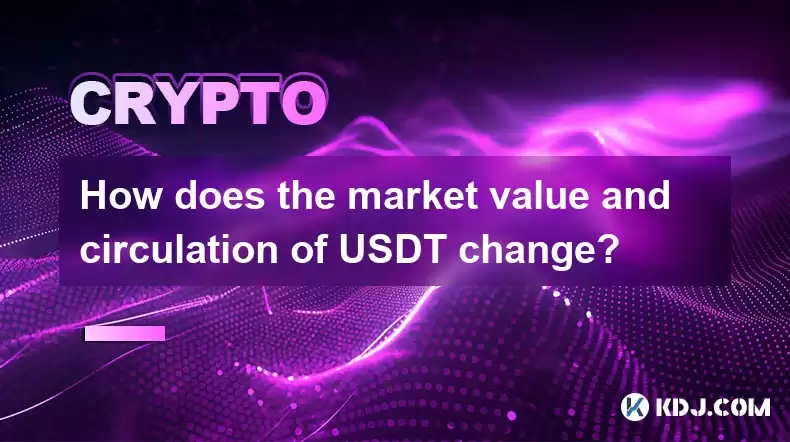
How Does the Market Value and Circulation of USDT Change?
Key Points:
- USDT's market value fluctuates based on supply and demand, influenced by factors like Bitcoin price, regulatory scrutiny, and overall market sentiment.
- USDT's circulation is impacted by Tether's issuance and redemption policies, as well as user adoption and trading activity.
- Understanding the dynamics of USDT's market value and circulation requires analyzing on-chain data, Tether's financial reports (though their transparency is debated), and broader macroeconomic conditions.
- The relationship between USDT and other stablecoins, as well as its role in the crypto market, significantly impacts its value and circulation.
- Understanding USDT's Market Value Fluctuations:
The market value of USDT, unlike other cryptocurrencies, isn't primarily determined by its underlying technology or adoption rate in decentralized applications. Instead, its value is pegged to the US dollar, aiming for a 1:1 ratio. However, this peg is not always perfectly maintained, leading to fluctuations. These fluctuations arise from several interconnected factors:
- Supply and Demand: The fundamental economic principle of supply and demand significantly influences USDT's market value. When demand for USDT increases (e.g., during periods of market uncertainty where traders seek a safe haven asset), its price can temporarily rise above $1. Conversely, if users redeem large amounts of USDT for USD, the supply increases, potentially pushing the price slightly below $1. This dynamic is influenced by several factors. For instance, a surge in Bitcoin's price might lead to more traders converting their profits into USDT, driving up demand. Conversely, news of regulatory scrutiny towards Tether or concerns about its reserves could trigger a rush to redeem USDT, increasing supply and potentially putting downward pressure on its price.
- Bitcoin's Price Influence: Bitcoin's price often acts as a significant driver for USDT's market value. When Bitcoin experiences a sharp rise, traders often use USDT to purchase it, thus increasing demand for USDT. Conversely, a Bitcoin price crash can lead to traders selling their Bitcoin holdings and converting the proceeds back into USDT, thereby potentially increasing the supply and putting downward pressure on the price. The correlation isn't always perfect, but it's a strong influence, particularly during periods of high volatility. This is because Bitcoin remains the dominant cryptocurrency, and USDT often acts as a bridge currency in Bitcoin trading. A significant movement in Bitcoin's price will ripple through the entire cryptocurrency market, including the stablecoin sector. The interconnectedness is evident in the trading volumes associated with Bitcoin pairs, many of which are quoted in USDT.
- Regulatory Scrutiny and Market Sentiment: Regulatory actions and investigations into Tether and its reserves heavily influence market sentiment and, subsequently, USDT's market value. Negative news or uncertainty regarding the transparency of Tether's reserves can trigger a sell-off, leading to a temporary drop below the $1 peg. Conversely, positive news or regulatory clarity can bolster confidence, stabilizing the price and potentially pushing it closer to the $1 mark. This is because trust is paramount in the stablecoin market. Any perception of risk or lack of transparency can significantly impact the market's willingness to hold USDT, which, in turn, affects its value. This highlights the importance of regulatory compliance and clear communication from Tether regarding its reserves and operational practices.
- Overall Market Sentiment: The broader sentiment within the cryptocurrency market also impacts USDT's value. During periods of general market optimism, traders might be more willing to hold USDT, potentially pushing its price slightly above $1. However, during periods of fear, uncertainty, and doubt (FUD), traders might rush to redeem their USDT, leading to increased supply and a potential drop below $1. This is a significant factor because stablecoins are often considered safe haven assets during periods of market turmoil. However, the extent to which USDT fulfills this role is subject to market perception and trust in Tether's operations.
- Understanding USDT's Circulation Changes:
The circulation of USDT, referring to the total amount of USDT in existence and actively circulating within the cryptocurrency ecosystem, is also subject to dynamic changes. These changes are primarily driven by:
- Tether's Issuance and Redemption Policies: The primary driver of USDT circulation is Tether's own actions. Tether can increase the supply by issuing new USDT, often in response to increased demand. Conversely, it can reduce the supply when users redeem their USDT for US dollars. The transparency of these actions, however, remains a point of contention within the cryptocurrency community. Critics argue that Tether lacks sufficient transparency in its issuance and redemption processes, raising concerns about the potential for manipulation.
- User Adoption and Trading Activity: The overall adoption of USDT within the cryptocurrency market significantly influences its circulation. Increased adoption by exchanges, traders, and decentralized applications leads to a higher demand for USDT, resulting in an increase in circulation. Conversely, decreased adoption or a shift towards other stablecoins could lead to a decrease in circulation. The popularity of USDT is closely tied to its liquidity and accessibility. It's widely accepted on most major cryptocurrency exchanges, making it a convenient tool for trading various cryptocurrencies. This widespread acceptance fuels its circulation.
- On-Chain Data Analysis: Analyzing on-chain data provides valuable insights into USDT's circulation patterns. By tracking the flow of USDT across various blockchains, researchers can gain a better understanding of its usage and distribution. This data can reveal trends in adoption, trading activity, and overall market sentiment. However, the complexity of analyzing on-chain data requires specialized skills and tools. It's not a straightforward process, and interpreting the data requires expertise in blockchain technology and data analysis.
- Relationship with Other Stablecoins: The emergence of other stablecoins, such as USDC and BUSD, presents competition for USDT. If users shift their preference to alternative stablecoins, the circulation of USDT could potentially decline. This competitive landscape necessitates Tether maintaining its reputation and operational efficiency to retain its market share. The competitive dynamics among stablecoins are constantly evolving, making it crucial to monitor market trends and user preferences.
- Macroeconomic Conditions: Broader macroeconomic factors can also influence USDT's circulation. During periods of global economic uncertainty, investors might seek refuge in stablecoins, leading to increased demand and circulation. Conversely, periods of economic stability might reduce the demand for stablecoins, impacting USDT's circulation. This highlights the interconnectedness of the cryptocurrency market with traditional finance. Global economic trends often influence the behavior of cryptocurrency investors, including their preference for stablecoins.
FAQs:
Q: Is USDT truly backed by 1:1 US dollar reserves?
A: Tether claims to maintain a 1:1 backing for its USDT, but the exact nature and composition of its reserves have been a subject of ongoing debate and scrutiny. While Tether periodically releases reports detailing its holdings, the level of transparency remains a point of contention within the crypto community. Independent audits have been requested and debated extensively, adding to the ongoing discussion surrounding the veracity of their claims.
Q: What are the risks associated with holding USDT?
A: While USDT aims to maintain a stable $1 value, there are inherent risks. These include the risk of de-pegging, meaning the value of USDT deviates significantly from $1, potentially resulting in losses for holders. Regulatory risks, related to potential legal challenges or restrictions on Tether's operations, also exist. Furthermore, the lack of complete transparency regarding Tether's reserves introduces an element of counterparty risk.
Q: How does the price of USDT affect the broader cryptocurrency market?
A: USDT's price stability is crucial for the functioning of the cryptocurrency market. If USDT de-pegs, it can trigger significant volatility across other cryptocurrencies as traders might lose confidence in the entire market. USDT serves as a critical intermediary currency for many trades, and its stability is essential for efficient and reliable trading. A significant deviation from the $1 peg can cascade through the market, causing widespread price fluctuations.
Q: What are the alternatives to USDT?
A: Several alternative stablecoins exist, including USDC, BUSD, and DAI. These stablecoins offer varying levels of transparency, backing mechanisms, and regulatory compliance. Choosing an alternative depends on individual risk tolerance and preferences. It's crucial to research each stablecoin thoroughly before investing, considering factors like the backing mechanism, audit history, and regulatory compliance.
Q: How can I track the circulation of USDT?
A: You can monitor the circulating supply of USDT through various resources, including cryptocurrency market data websites (like CoinMarketCap or CoinGecko) and blockchain explorers. However, remember that these sources might not always provide a completely real-time or perfectly accurate picture. On-chain analysis, though requiring more technical expertise, can provide a deeper understanding of USDT's flow and distribution across various networks. Combining information from multiple sources will give a more holistic view.
Disclaimer:info@kdj.com
The information provided is not trading advice. kdj.com does not assume any responsibility for any investments made based on the information provided in this article. Cryptocurrencies are highly volatile and it is highly recommended that you invest with caution after thorough research!
If you believe that the content used on this website infringes your copyright, please contact us immediately (info@kdj.com) and we will delete it promptly.
- Bitcoin, Ruvi AI, and CoinMarketCap: Navigating the Future of Crypto
- 2025-07-28 02:30:12
- Dogwifhat (WIF) Eyes Bullish Breakout: Can It Breach $1.20?
- 2025-07-28 02:50:12
- Bitcoin Bounces: How the US-China Tariff Truce Impacts Crypto
- 2025-07-28 02:50:12
- Bitcoin Bull Market: Price Targets and Expert Takes
- 2025-07-28 02:30:12
- Cardano Price Rockets: ADA Jumps Past Resistance, $2 Target in Sight?
- 2025-07-28 01:30:14
- Ruvi AI: The Next Solana? Riding the AI Token Wave on CoinMarketCap
- 2025-07-28 00:50:16
Related knowledge

How to choose a reliable USDT exchange service provider? How to identify?
Jun 12,2025 at 03:15pm
Understanding the Role of USDT in Cryptocurrency TradingUSDT (Tether) is one of the most widely used stablecoins in the cryptocurrency market. It is d...
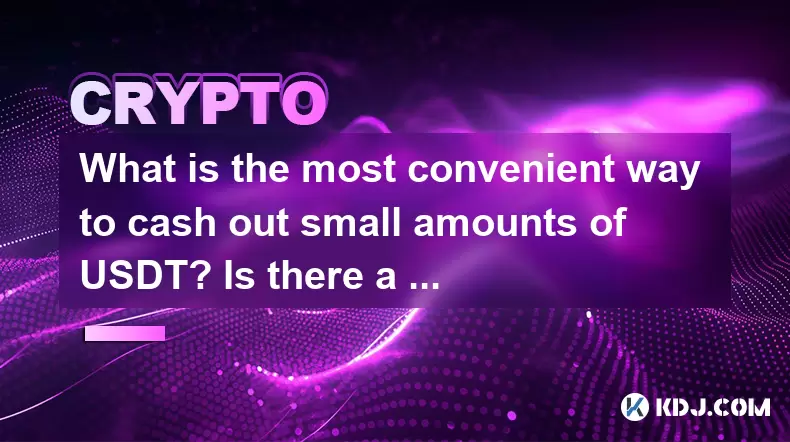
What is the most convenient way to cash out small amounts of USDT? Is there a shortcut?
Jun 11,2025 at 11:00pm
Understanding the Need to Cash Out Small USDT AmountsCashing out small amounts of USDT can be a challenge for many crypto users. Traditional methods o...

How to transfer USDT to PayPal or international payment tools?
Jun 15,2025 at 05:28am
Understanding the Basics of USDT and PayPal IntegrationUSDT (Tether) is a stablecoin pegged to the US dollar, offering blockchain-based value transfer...
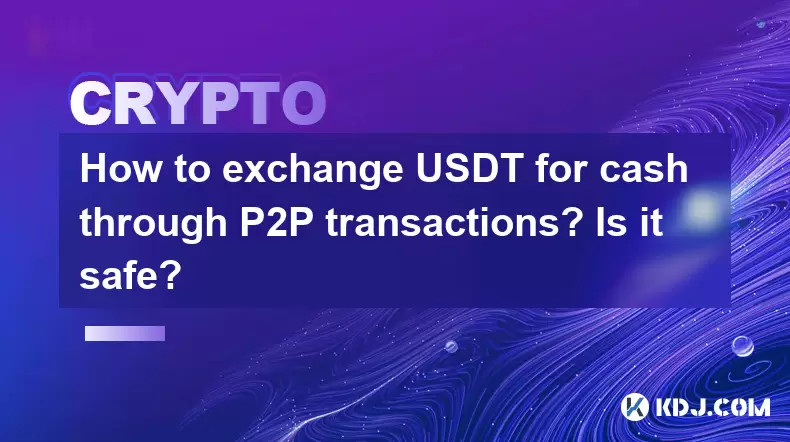
How to exchange USDT for cash through P2P transactions? Is it safe?
Jun 18,2025 at 07:56am
Understanding USDT and P2P TransactionsTether (USDT) is a stablecoin pegged to the value of the US dollar, making it a popular choice for users who wa...
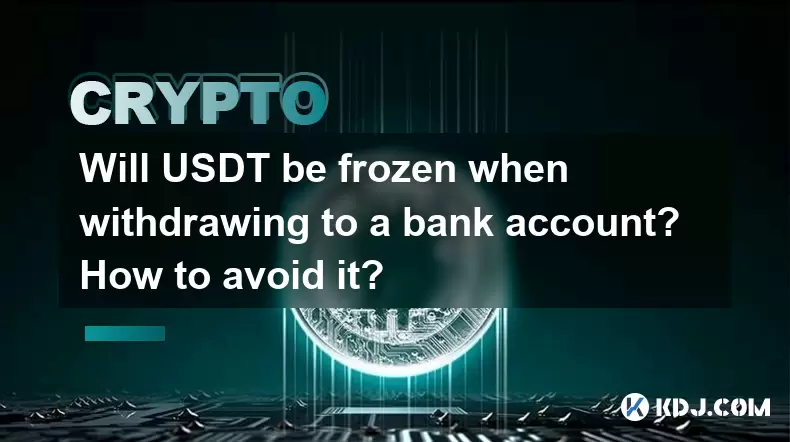
Will USDT be frozen when withdrawing to a bank account? How to avoid it?
Jun 15,2025 at 10:03am
Understanding USDT Withdrawals and Bank Account Freezing RisksWhen users decide to withdraw USDT (Tether) to a bank account, one of the most common co...
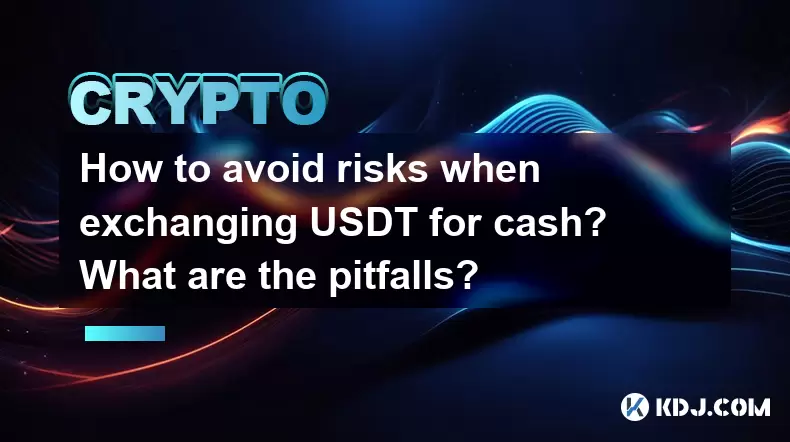
How to avoid risks when exchanging USDT for cash? What are the pitfalls?
Jun 11,2025 at 08:14pm
Understanding the Risks of Exchanging USDT for CashWhen exchanging USDT (Tether) for cash, users must be aware of the potential risks involved. As a s...

How to choose a reliable USDT exchange service provider? How to identify?
Jun 12,2025 at 03:15pm
Understanding the Role of USDT in Cryptocurrency TradingUSDT (Tether) is one of the most widely used stablecoins in the cryptocurrency market. It is d...

What is the most convenient way to cash out small amounts of USDT? Is there a shortcut?
Jun 11,2025 at 11:00pm
Understanding the Need to Cash Out Small USDT AmountsCashing out small amounts of USDT can be a challenge for many crypto users. Traditional methods o...

How to transfer USDT to PayPal or international payment tools?
Jun 15,2025 at 05:28am
Understanding the Basics of USDT and PayPal IntegrationUSDT (Tether) is a stablecoin pegged to the US dollar, offering blockchain-based value transfer...

How to exchange USDT for cash through P2P transactions? Is it safe?
Jun 18,2025 at 07:56am
Understanding USDT and P2P TransactionsTether (USDT) is a stablecoin pegged to the value of the US dollar, making it a popular choice for users who wa...

Will USDT be frozen when withdrawing to a bank account? How to avoid it?
Jun 15,2025 at 10:03am
Understanding USDT Withdrawals and Bank Account Freezing RisksWhen users decide to withdraw USDT (Tether) to a bank account, one of the most common co...

How to avoid risks when exchanging USDT for cash? What are the pitfalls?
Jun 11,2025 at 08:14pm
Understanding the Risks of Exchanging USDT for CashWhen exchanging USDT (Tether) for cash, users must be aware of the potential risks involved. As a s...
See all articles

























































































